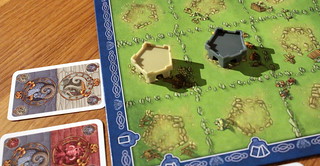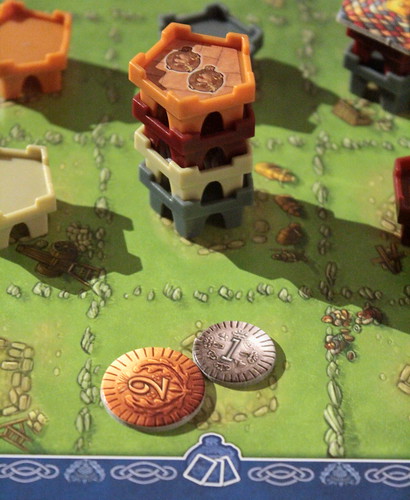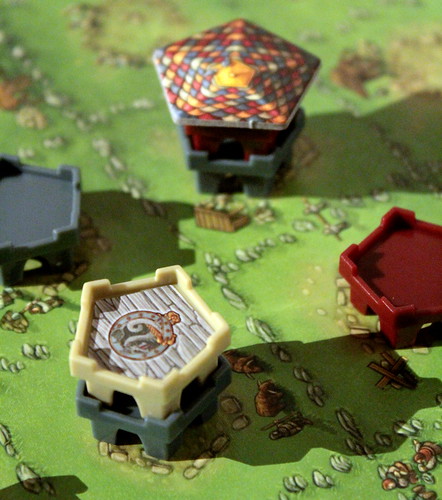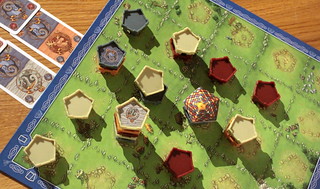| Strategy | Luck |
|---|---|
| Interaction | Components & Design |
| Complexity | Score |
Highland Land Development Plan – The Rules
The castle of the McKilt clan is to be constructed on a game board of five by five spaces, with three of them in one corner being unavailable because of loch. On the remaining spaces the up to four players of Kilt Castle will build Castle Kilt. How they do that is one of those Scottish peculiarities. Around the game board are stacks of cards, one card for each player showing only their color, one card for each possible pair of colors.

Each turn, the current player picks up one card and moves it clockwise around the board. The player or players who’s color is shown on that card may place one floor in the row where the card landed. Any card really means any card, it doesn’t have to be the top card on a stack, and it doesn’t have to show the current players color, either. It is possible, and sometimes clever, to force other players to build. There are very few restrictions to where you can place those cards as well. You can only ever have five rows of cards, a row can not have more than four cards and when you start a new row you can not leave a gap behind it.
The rules for placing a new floor on the board are equally simple. You only have two options: either you place a floor on the first free space in the row where the card landed, or you place a floor on top of an existing tower and pay the owner of the current top floor one coin for each floor in that tower. One snag is that, as long as you can build, you have to. That also applies when your only chance to build costs you money: if you can afford it, you have to take it. That’s why forcing others into building can be fun and profitable at the same time.

That money has to come from somewhere, just passing it around the table for topping each others’ towers wouldn’t be much fun. How to get fresh money is the reason why you want your floors to be on top of the towers. Whenever someones takes the last card out of a row of cards he triggers a Ducat Day. Never mind that Scotland never used Ducats. They will probably start to when they leave the United Kingdom. On a Ducat Day, every player finds the most valuable, uninterrupted area of towers with his own color on top. For each tower in that area, and for each of his seals shown on those towers, he takes one coin. Creating a large, profitable area is tough, but the real problem is keeping it once your opponents realize just how much money it makes for you.
One additional detail that really improves the game are the roofs. When the two players on a two color card build on the same space, that tower is topped with a roof. While the roof is there, no one can build on top of this tower. But mostly people don’t want to, either, because a tower with a roof counts as every player’s color when determining your most valuable area. Roofs are are the same time a peaceful way for all players to expand their holdings and a way to cement your largest area by protecting a bottlenecks where two areas run together. Once a roof is on, the only way to remove it is to build a roof somewhere else: There are only two roofs available, so when you need a third one you remove one of the others.
Is it a tourist attraction? – The Verdict

Let’s get the obvious out of the way first: the theme in Kilt Castle is nonsense. The game’s building rules do not evoke anything like building a castle, not in quirky Scotland or anywhere else. My guess is that it had to get a theme because abstract strategy games don’t sell well in the family market.
So let’s judge it for what it is, an abstract strategy game. Kilt Castle is light enough on the rules that you can explain it in two minutes if you have to. The only bit of randomness is in the initial setup of the building cards, after that everything that happens is because someone decided it.
Kilt Castle does feel rather different with two or four players. With two players you can think about an actual strategy, with four players your decisions become much more tactical. The board changes too much between your chances to build. But don’t get me wrong, you still win a four player game of Kilt Castle by making better decisions than everyone else. The difference is what good decisions look like.
Finally, a look at the components. When I unpacked the game, my first thought was that 64 plastic tower floors might be a tad overproduced. My second thought was that I would prefer wooden pieces. I revised both of those thoughts while playing, because the plastic pieces work perfectly where wooden ones wouldn’t. The floors stack in a way that makes it almost impossible to accidentally knock over a tower. (Intentionally knocking over a tower is a different story. I lost a few games pretty badly.) The same could have been achieved with wood, but making pieces that stack like this would have been harder. So yeah, the towers are plastic and may be more elaborate than Kilt Castle needed, but they work perfectly.

That leaves me with the pasted on theme as the one thing to criticize. You just keep thinking how little sense it makes – but that’s just when you’re not thinking about how to make the most points on your next move. You make many decisions during a game of Kilt Castle, and virtually none of them are meaningless. The rules are simple, but between placing the roofs right, forcing other players to build where they don’t want to and triggering Ducat Days when you profit the most, there are many nuances to Kilt Castle that make it interesting. How you build your own area and disrupt the other players’ is also very interactive. Kilt Castle is light enough to play as a family game, but it works equally well for a group of gamers in the mood for a lighter abstract.










The redesign looks nice. Saw the announcement on Instagram, but didn’t see it live yet. Nice work!
Thank you! It was a scary step, changing out old and trusty look, so we’re really glad you like it.
Lion Rampant began shipping stores in North America today.
Thanks for letting us know, that’s great news!